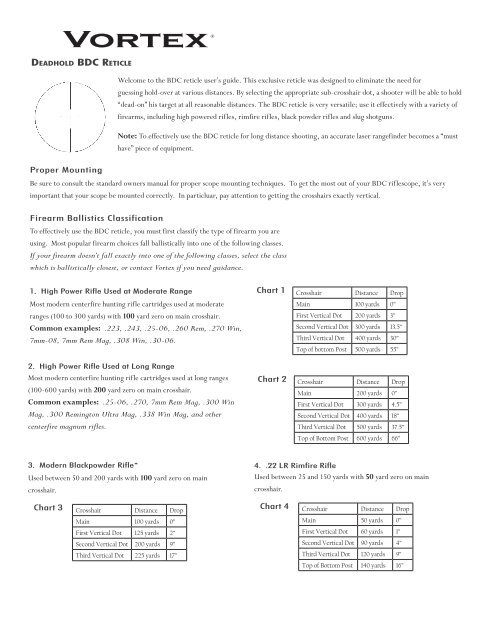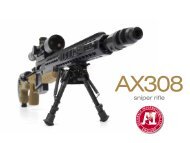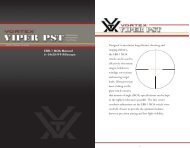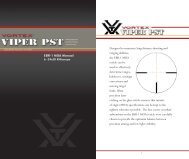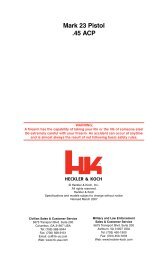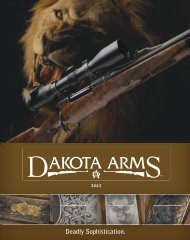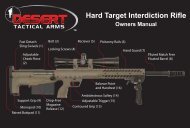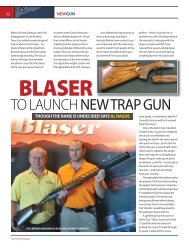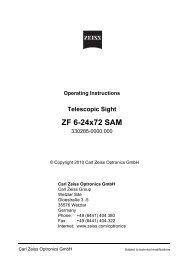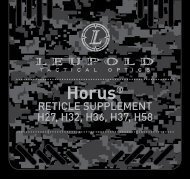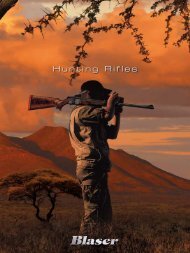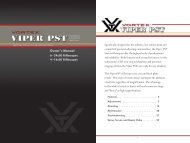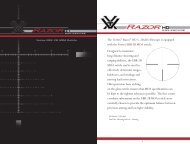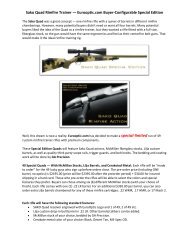Vortex Dead-Hold BDC reticle manual - EuroOptic.com
Vortex Dead-Hold BDC reticle manual - EuroOptic.com
Vortex Dead-Hold BDC reticle manual - EuroOptic.com
- No tags were found...
You also want an ePaper? Increase the reach of your titles
YUMPU automatically turns print PDFs into web optimized ePapers that Google loves.
<strong>Vortex</strong>®<strong>Dead</strong>hold <strong>BDC</strong> ReticleWel<strong>com</strong>e to the <strong>BDC</strong> <strong>reticle</strong> user’s guide. This exclusive <strong>reticle</strong> was designed to eliminate the need forguessing hold-over at various distances. By selecting the appropriate sub-crosshair dot, a shooter will be able to hold“dead-on” his target at all reasonable distances. The <strong>BDC</strong> <strong>reticle</strong> is very versatile; use it effectively with a variety offirearms, including high powered rifles, rimfire rifles, black powder rifles and slug shotguns.Note: To effectively use the <strong>BDC</strong> <strong>reticle</strong> for long distance shooting, an accurate laser rangefinder be<strong>com</strong>es a “musthave” piece of equipment.Proper MountingBe sure to consult the standard owners <strong>manual</strong> for proper scope mounting techniques. To get the most out of your <strong>BDC</strong> riflescope, it’s veryimportant that your scope be mounted correctly. In particluar, pay attention to getting the crosshairs exactly vertical.Firearm Ballistics ClassificationTo effectively use the <strong>BDC</strong> <strong>reticle</strong>, you must first classify the type of firearm you areusing. Most popular firearm choices fall ballistically into one of the following classes.If your firearm doesn’t fall exactly into one of the following classes, select the classwhich is ballistically closest, or contact <strong>Vortex</strong> if you need guidance.1. High Power Rifle Used at Moderate RangeMost modern centerfire hunting rifle cartridges used at moderateranges (100 to 300 yards) with 100 yard zero on main crosshair.Common examples: .223, .243, .25-06, .260 Rem, .270 Win,7mm-08, 7mm Rem Mag, .308 Win, .30-06.2. High Power Rifle Used at Long RangeMost modern centerfire hunting rifle cartridges used at long ranges(100-600 yards) with 200 yard zero on main crosshair.Common examples: .25-06, .270, 7mm Rem Mag, .300 WinMag, .300 Remington Ultra Mag, .338 Win Mag, and othercenterfire magnum rifles.Chart 1Chart 2Crosshair Distance DropMain 100 yards 0”First Vertical Dot 200 yards 3”Second Vertical Dot 300 yards 13.5”Third Vertical Dot 400 yards 30”Top of bottom Post 500 yards 55”Crosshair Distance DropMain 200 yards 0”First Vertical Dot 300 yards 4.5”Second Vertical Dot 400 yards 18”Third Vertical Dot 500 yards 37.5”Top of Bottom Post 600 yards 66”3. Modern Blackpowder Rifle*Used between 50 and 200 yards with 100 yard zero on maincrosshair.4. .22 LR Rimfire RifleUsed between 25 and 150 yards with 50 yard zero on maincrosshair.Chart 3Crosshair Distance DropMain 100 yards 0”First Vertical Dot 125 yards 2”Second Vertical Dot 200 yards 9”Third Vertical Dot 225 yards 17”Chart 4Crosshair Distance DropMain 50 yards 0”First Vertical Dot 60 yards 1”Second Vertical Dot 90 yards 4”Third Vertical Dot 120 yards 9”Top of Bottom Post 140 yards 16”
5. .17 HMR Rimfire Rifle (17 gr. bullet)Used between 50 and 300 yards with 100 yard zero on maincrosshair.Chart 5Chart 6Crosshair Distance DropCrosshair Distance DropMain 100 yards 0”Main 50 yards 0”First Vertical Dot 150 yards 2.5”First Vertical Dot 75 yards 1”Second Vertical Dot 200 yards 8.5”Second Vertical Dot 100 yards 4.5”Third Vertical Dot 250 yards 19.1”Third Vertical Dot 125 yards 9.4”Top of Bottom Post 300 yards 36.1”Set-up and UseIt is necessary to first sight-in the main crosshair to the zero range inthe ballistic class you’ve selected—consult the riflescope <strong>manual</strong> ifyou need assistance. Each firearm class uses a different correspondingrange to each sub-crosshair dot depending on ballistic performance.6. Slug Shotgun and Traditional Black Powder Rifle*Used between 25 and 150 yards with 50 yard zero on main crosshair.*Note: Due to the differences in available black powder equipment, these numbers should be viewed only as arepresentative sample. It’s important to learn the ballistics of the particluar black powder equipment you’re using.It’s very important to understand that the <strong>Vortex</strong> <strong>Dead</strong>-<strong>Hold</strong> <strong>BDC</strong><strong>reticle</strong> will only work for different ranges at the highest magnificationsetting of your riflescope. The main crosshair and its correspondingrange can be used at any magnification.The real key to understanding and using the <strong>Dead</strong>-<strong>Hold</strong> <strong>BDC</strong> <strong>reticle</strong>effectively and responsibly is to recognize that you must spend timeat the rifle range to fine-tune the match between your particularrifle/ammo <strong>com</strong>bo and the <strong>BDC</strong> <strong>reticle</strong>. While most rifle/ammo<strong>com</strong>binations will fall into the ballistic classes we have supplied,there will still besome variation (mostdifferences being lessthan four inches).Once you have the maincrosshair sighted in,it is vitally importantto shoot at the various 1. First Vertical Dot (1.5 MOA)distances to learn2. Second Vertical Dot (4.5 MOA)where your particular 3. Third Vertical Dot (7.5 MOA)<strong>com</strong>bination of weapon 4. Top of Bottom Post (11 MOA)and ammo will varyfrom the charts we have supplied. Ammunition manufacturers will alsosupply you with ballistics charts for their products, and many can belooked up on the Internet. After you have learned these differences, keeptrack of them! We have supplied small, sticky-backed decals to assistin this. Using the spaces provided, label the correct yardages and yourdifferences.Because <strong>Vortex</strong> riflescopes allow re-indexing of the elevationknob (see owner’s <strong>manual</strong>) after sight-in, it is quite easy to quicklydial in a needed adjustment, and then return right back to theoriginal zero.ExampleLet’s say you’re going to shoot your .30-06 with 180 grain bullets(Chart 1, using 100 yard zero) at 400 yards. You know throughpractice that with your particular rifle and ammo, the bulletdrops 34 inches rather than the 30 inches stated in the chart. Tobe exactly on the money, you’ve got to dial in for another fourinches of drop. Four inches at 400 yards is equal to 1 MOA (seemain <strong>manual</strong> for minute of angle information). All you have todo to make your shot is dial the elevation turret to #1 MOA Up(four 1/4 minute clicks “up”). After the shot, simply return theelevation turret to “0” to be right back to your originalzero and ready for the next shot...you did have your turret reindexedto zero after sight-in, right?!The <strong>Dead</strong>-<strong>Hold</strong> <strong>BDC</strong> <strong>reticle</strong> also incorporates a method of rangeand wind drift estimation using the dots on the crosshairs. Again,this method works only with your riflescope at the highestmagnification setting. Dots on the vertical crosshair are spacedat 1.5 MOA, 4.5 MOA and 7.5 MOA. The top of the bottomvertical heavy crosshair is 11 MOA from center. 1 MOA closelyequals 1 inch at 100 yards, 2 inches at 200 yards, 3 inches at300 yards, and so on.Keep in mind that everyone’s application will be different. If you area big game hunter, a ballistic difference of an inch or two at moderateranges may be acceptable; if you are a long distance target or varmintshooter, an inch or two difference might result in a miss. However,once you have learned these differences it’s very easy to <strong>com</strong>pensate.1. Horizontal Crosshair Dots (3.44 MOA)2. Inside Horizontal Posts (6.88 MOA)
Similar to a Mil Dot system, the two dots on the horizontal crosshair arespaced at 3.44 MOA (1 mil) and the inside ends of the heavy horizontalcrosshairs at 6.88 MOA (2 mils) from center (3.6 or 7.2 inches at 100yards, 7.2 or 14.4 inches at 200 yards, 14.4 or 21.6 inches at 300 yards,and so on.Knowing these numbers, a shooter can <strong>com</strong>pare an object of knowndimensions (at the shooting distance) to the dot spacing, and roughlyestimate the range. Also, a shooter familiar with the wind drift numbersof his particular ammunition can use the dot spacing to help estimateproper windage hold-off once the correct range and wind are known(there are many good sources for wind drift available).ExampleSpotting a distant buck while deer hunting, you turn your scope to itshighest power and range him. You see that the area from the top of hisback to the bottom of his chest (usually a depth of about 18 inches on amaturebuck) spans the distance from the center crosshair to theseconddot down (4.5 MOA). You know that 4.5 MOA equals 4.5 inches at 100yards, 9 inches at 200 yards, 13.5 inches at 300 yards, and 18 inches at400 yards. Since you know the span you’re measuring is 18 inches, younow know the buck is 400 yards away.A useful formula when using the Mil Dot spacing (3.6 MOA) on thehorizontal crosshair is below. The horizontal dots can estimate from oneto four mils.Known Object’sWidth (or Height) in Yards x 1000Object’s Width (or Height) in Mils= Range in YardsExampleHunting in your home area, you know that a coyote runs about threefeet in body and head length. With your scope set at highest power, younotice a coyote’s body covers about the distance from the center crosshairto the edge of the heavy part of the horizontal crosshair (2 mils).1 Yard (3 Feet) x 10002 Mils= 500 YardsYou can see from this formula that the coyote would be at a distance of500 yards.Unlimited • Unconditional • TransferableWe at <strong>Vortex</strong> Optics want you to use and enjoy your optics with <strong>com</strong>pleteconfidence . . . that’s why our V.I.P. warranty is so straightforward.Should your <strong>Vortex</strong> Optics product ever require service, we will repairor replace it absolutely free - no matter what the cause!The VIP warranty is a Very Important Promise to you . . . because youare a very important person to us. Each <strong>Vortex</strong> binocular, spottingscope and riflescope is built to last, and unconditionally guaranteedwith our <strong>com</strong>mitment to your absolute satisfaction.<strong>Vortex</strong> Optics ® believes strongly in responsible,ethical hunting and a word should be said about thedifficulty of long range shooting at game. Although <strong>reticle</strong>slike the <strong>Vortex</strong> “Mil Dot” can make long distance shotsmuch easier, there are still many variables at play affectingevery shot. This type of shooting is not easy—plenty ofpractice is essential. Everyone doing this kind of shootingshould also learn their personal effective range, and NOTshoot beyond it at game. Your effective range will dependon what you’re shooting at: for big game, it might be therange at which you can keep all your shots inside of teninches, for smaller game it might be the range that all yourshots can be kept inside of three inches.Be responsible. The keys are knowing your rifle,ammunition and your own abilities!<strong>Vortex</strong> Optics2120 West Greenview DriveMiddleton, WI 53562(800) 426-0048info@vortexoptics.<strong>com</strong>© <strong>Vortex</strong> Optics USA


